8576 顺序线性表的基本操作
时间限制:1000MS 内存限制:1000K
提交次数:9027 通过次数:2456
题型: 编程题 语言: 无限制
Description
编写算法,创建初始化容量为LIST_INIT_SIZE 的顺序表T,并实现插入、删除、遍历操作。本题
目给出部分代码,请补全内容。
#include
#include
#define OK 1
#define ERROR 0
#define LIST_INIT_SIZE 100
#define LISTINCREMENT 10
#define ElemType int
typedef struct
{
int *elem;
int length;
int listsize;
}SqList;
int InitList_Sq(SqList &L)
{
// 算法2.3,构造一个空的线性表L,该线性表预定义大小为LIST_INIT_SIZE
// 请补全代码
}
�
int Load_Sq(SqList &L)
{
// 输出顺序表中的所有元素
int i;
if(_________________________) printf("The List is empty!"); // 请填空
else
{
printf("The List is: ");
for(_________________________)
",_________________________); // 请填空
printf("%d
}
printf("\n");
return OK;
}
int ListInsert_Sq(SqList &L,int i,int e)
{
// 算法2.4,在顺序线性表L 中第i 个位置之前插入新的元素e
// i 的合法值为1≤i≤L.length +1
// 请补全代码
}
int ListDelete_Sq(SqList &L,int i, int &e)
{
// 算法2.5,在顺序线性表L 中删除第i 个位置的元素,并用e 返回其值
// i 的合法值为1≤i≤L.length
// 请补全代码
�
}
int main()
{
SqList T;
int a, i;
ElemType e, x;
if(_________________________)
// 判断顺序表是否创建成功
{
}
printf("A Sequence List Has Created.\n");
while(1)
{
printf("1:Insert
element\n2:Delete
element\n3:Load
all
elements\n0:Exit\nPlease choose:\n");
scanf("%d",&a);
switch(a)
{
case 1: scanf("%d%d",&i,&x);
Error!\n"); // 判断i 值是否合法,请填空
if(_________________________)
printf("Insert
else printf("The Element %d is Successfully Inserted!\n",
x);
break;
case 2: scanf("%d",&i);
Error!\n"); // 判断i 值是否合法,请填空
if(_________________________)
printf("Delete
else printf("The Element %d is Successfully Deleted!\n",
e);
break;
�
case 3: Load_Sq(T);
break;
case 0: return 1;
}
}
}
输入格式
测试样例格式说明:
根据菜单操作:
1、输入1,表示要实现插入操作,紧跟着要输入插入的位置和元素,用空格分开
2、输入2,表示要实现删除操作,紧跟着要输入删除的位置
3、输入3,表示要输出顺序表的所有元素
4、输入0,表示程序结束
输入样例
1
1 2
1
1 3
2
1
3
0
输出样例
A Sequence List Has Created.
1:Insert element
�
2:Delete element
3:Load all elements
0:Exit
Please choose:
The Element 2 is Successfully Inserted!
1:Insert element
2:Delete element
3:Load all elements
0:Exit
Please choose:
The Element 3 is Successfully Inserted!
1:Insert element
2:Delete element
3:Load all elements
0:Exit
Please choose:
The Element 3 is Successfully Deleted!
1:Insert element
2:Delete element
3:Load all elements
0:Exit
Please choose:
The List is: 2
1:Insert element
2:Delete element
3:Load all elements
0:Exit
Please choose:
�
作者
yqm
解法一:(正规解法)
#include
#include
#define OK 1
#define ERROR 0
#define LIST_INIT_SIZE 100
#define LISTINCREMENT 10
#define ElemType int
typedef struct
{
int *elem;
int length;
int listsize;
}SqList;
int InitList_Sq(SqList &L)
{
// 算法2.3,构造一个空的线性表L,该线性表预定义大小为LIST_INIT_SIZE
// 请补全代码
L.elem=(ElemType*)malloc(LIST_INIT_SIZE*sizeof(ElemType));
L.length=0;
L.listsize=LIST_INIT_SIZE;
return 0;
�
}
int Load_Sq(SqList &L)
{
// 输出顺序表中的所有元素
int i;
if(L.length==0) printf("The List is empty!"); // 请填空
else
{
printf("The List is: ");
for(i=0;iL.length+1)return ERROR;
if(L.length>=L.listsize)
{
newbase=(ElemType*)realloc(L.elem,(L.listsize+LISTINCREMENT)*sizeof(El
emType));
L.elem=newbase;
�
L.listsize+=LISTINCREMENT;
}
q=&(L.elem[i-1]);
for(p=&(L.elem[L.length-1]);p>=q;--p)
*(p+1)=*p;
*q=e;
++L.length;
return OK;
}
int ListDelete_Sq(SqList &L,int i, int &e)
{
// 算法2.5,在顺序线性表L 中删除第i 个位置的元素,并用e 返回其值
// i 的合法值为1≤i≤L.length
// 请补全代码
ElemType *p,*q;
if(i<1||i>L.length)return ERROR;
p=&(L.elem[i-1]);
e=*p;
q=L.elem+L.length-1;
for(++p;p<=q;++p)
*(p-1)=*p;
--L.length;
return OK;
}
int main()
{
�


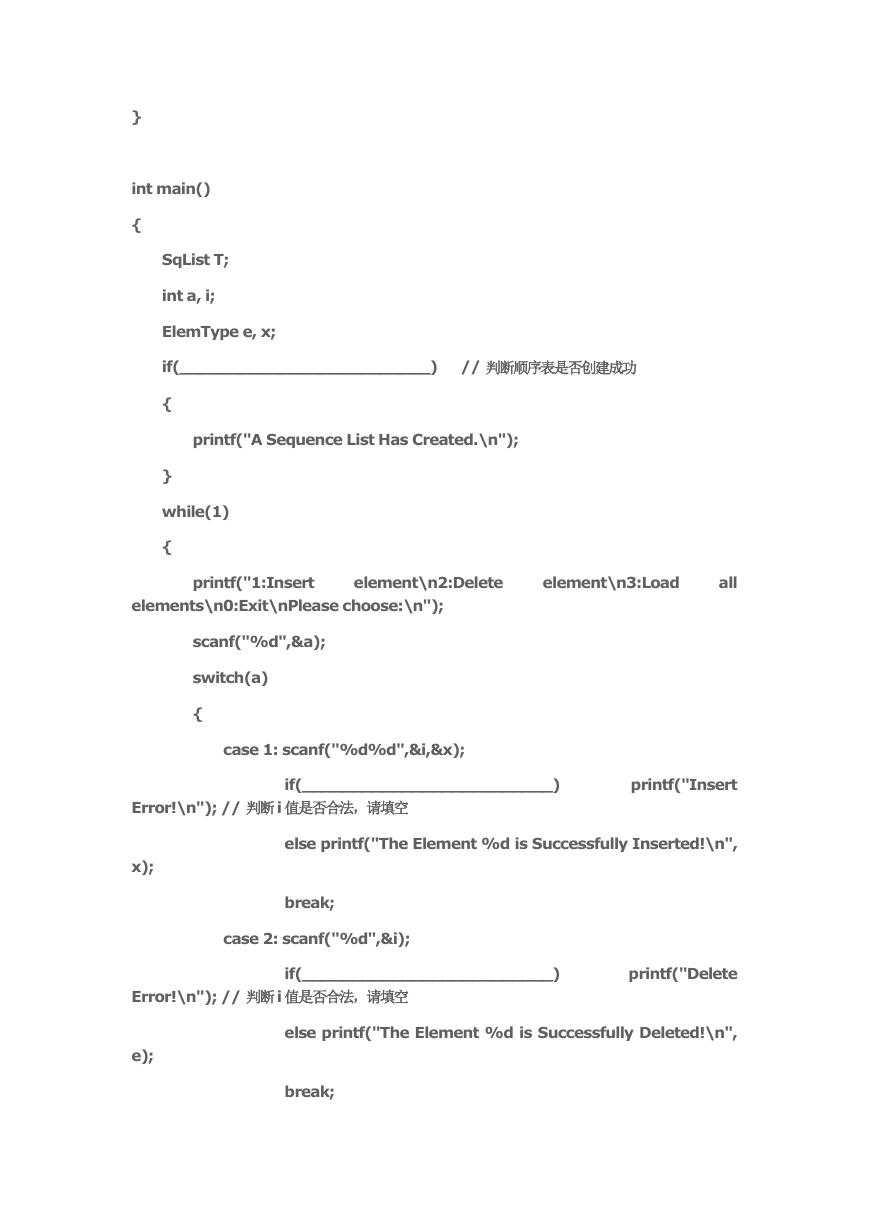
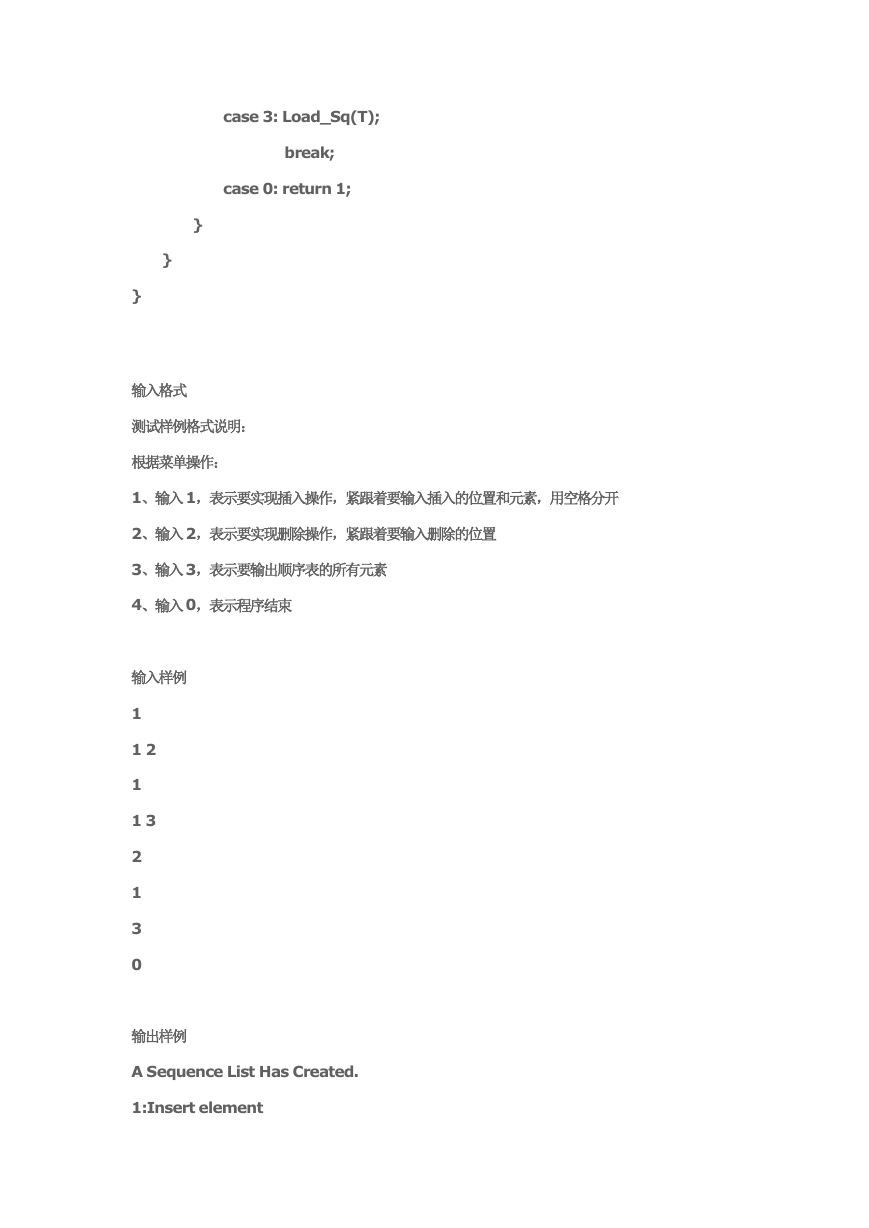
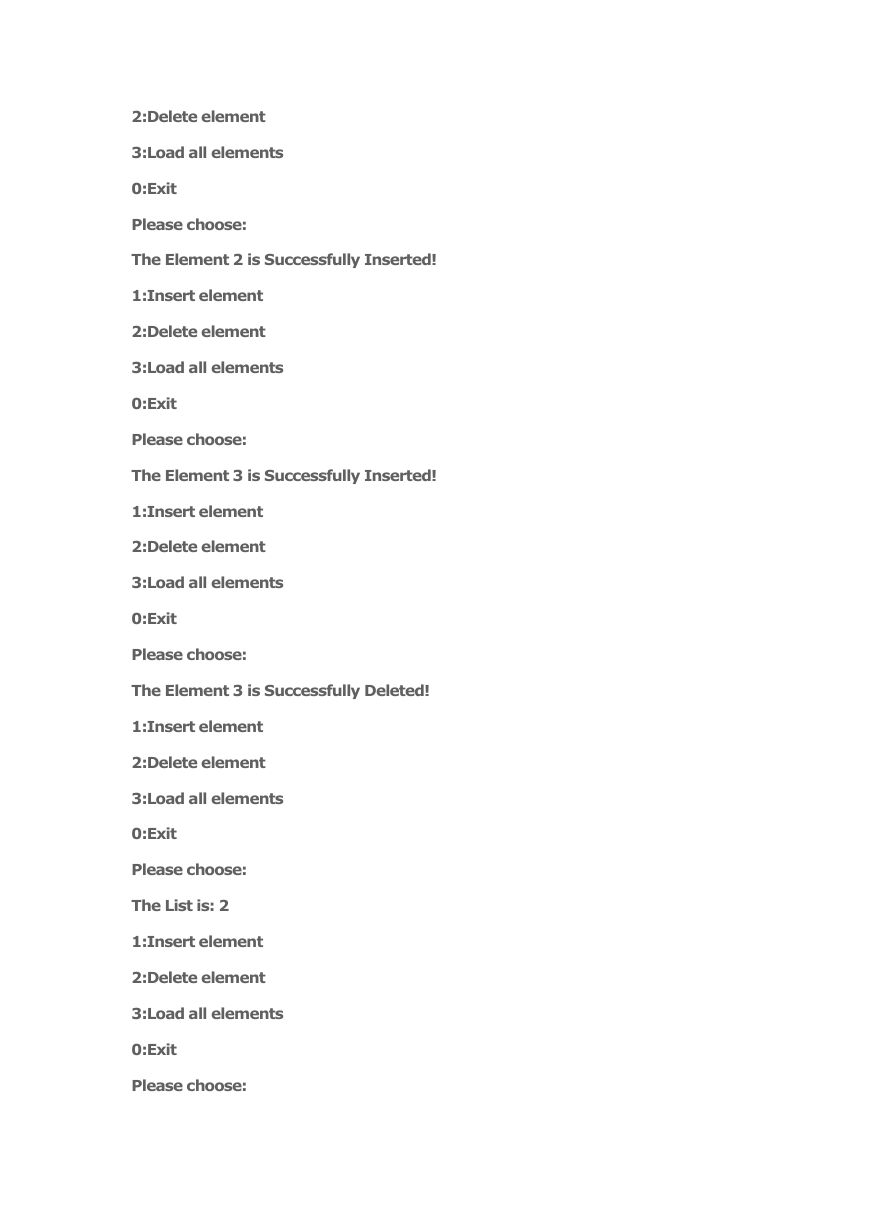
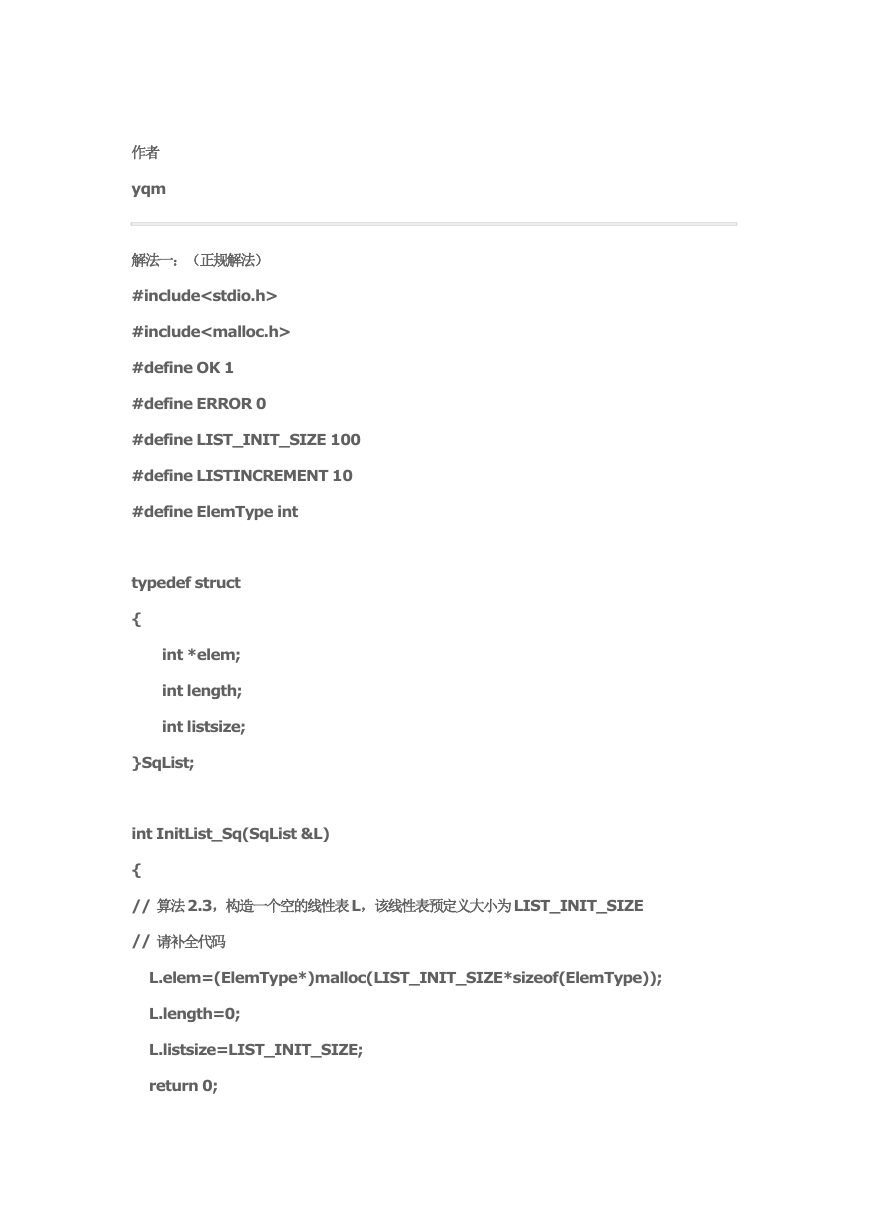
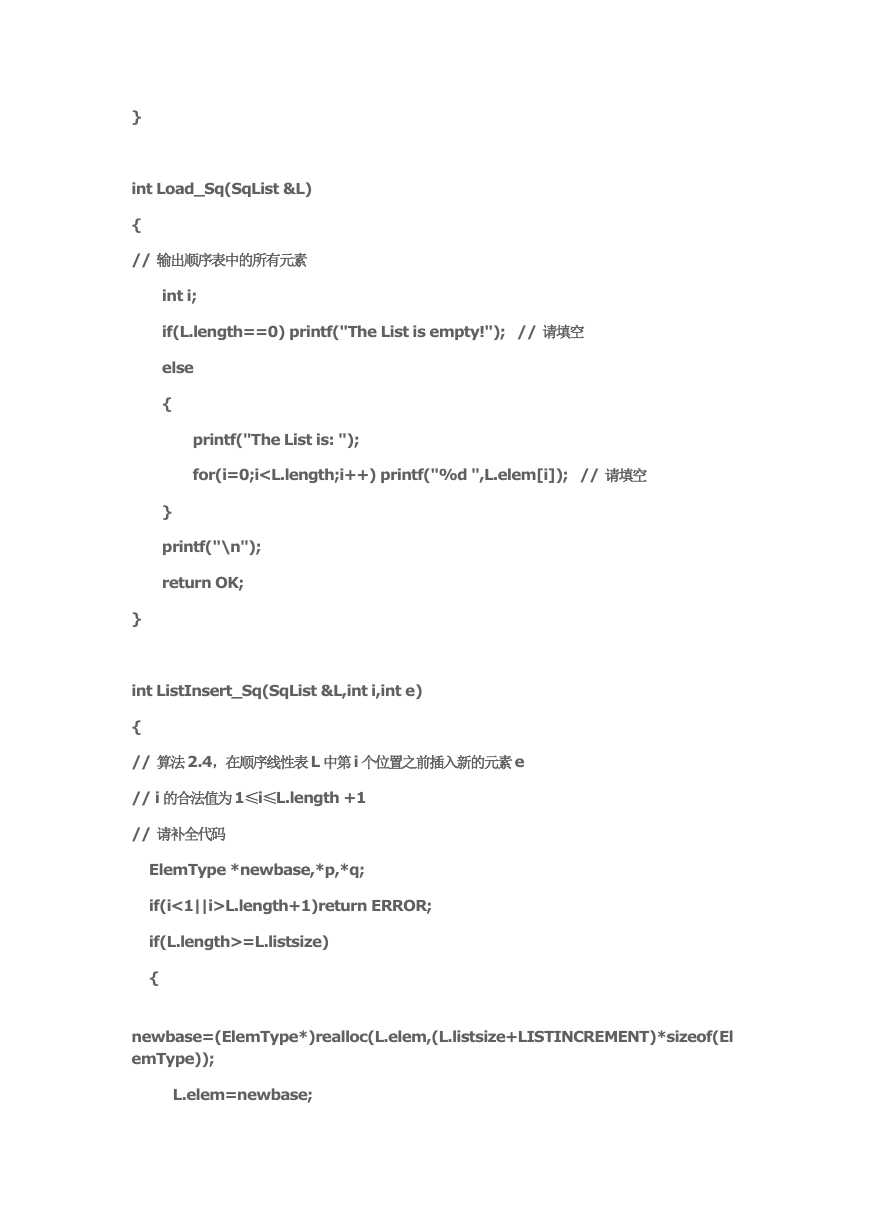
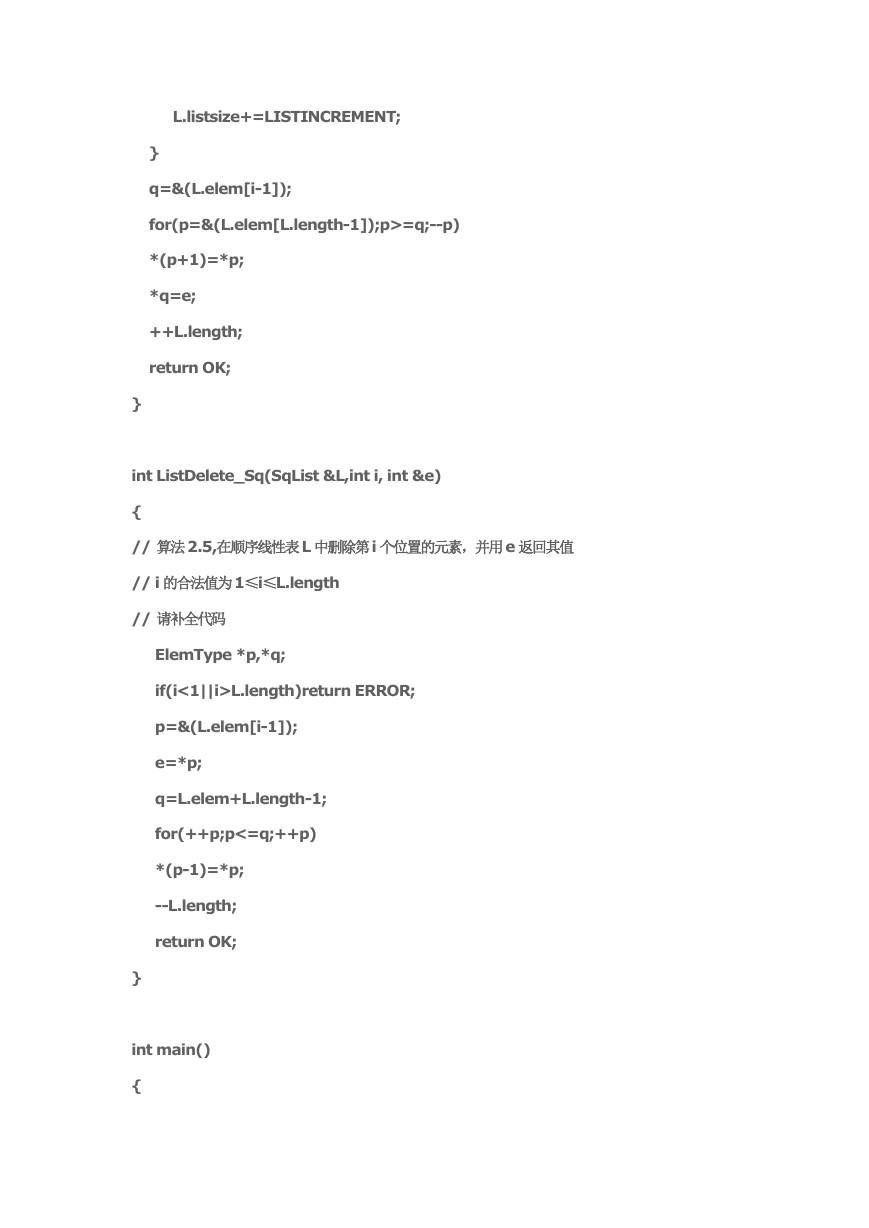








 2023年江西萍乡中考道德与法治真题及答案.doc
2023年江西萍乡中考道德与法治真题及答案.doc 2012年重庆南川中考生物真题及答案.doc
2012年重庆南川中考生物真题及答案.doc 2013年江西师范大学地理学综合及文艺理论基础考研真题.doc
2013年江西师范大学地理学综合及文艺理论基础考研真题.doc 2020年四川甘孜小升初语文真题及答案I卷.doc
2020年四川甘孜小升初语文真题及答案I卷.doc 2020年注册岩土工程师专业基础考试真题及答案.doc
2020年注册岩土工程师专业基础考试真题及答案.doc 2023-2024学年福建省厦门市九年级上学期数学月考试题及答案.doc
2023-2024学年福建省厦门市九年级上学期数学月考试题及答案.doc 2021-2022学年辽宁省沈阳市大东区九年级上学期语文期末试题及答案.doc
2021-2022学年辽宁省沈阳市大东区九年级上学期语文期末试题及答案.doc 2022-2023学年北京东城区初三第一学期物理期末试卷及答案.doc
2022-2023学年北京东城区初三第一学期物理期末试卷及答案.doc 2018上半年江西教师资格初中地理学科知识与教学能力真题及答案.doc
2018上半年江西教师资格初中地理学科知识与教学能力真题及答案.doc 2012年河北国家公务员申论考试真题及答案-省级.doc
2012年河北国家公务员申论考试真题及答案-省级.doc 2020-2021学年江苏省扬州市江都区邵樊片九年级上学期数学第一次质量检测试题及答案.doc
2020-2021学年江苏省扬州市江都区邵樊片九年级上学期数学第一次质量检测试题及答案.doc 2022下半年黑龙江教师资格证中学综合素质真题及答案.doc
2022下半年黑龙江教师资格证中学综合素质真题及答案.doc